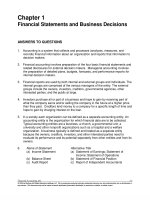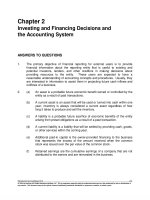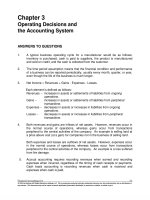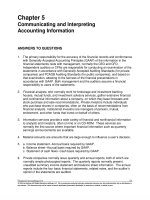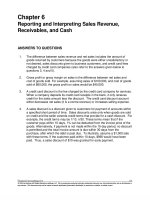Solution manual managerial accounting 8e by hansen mowen ch 14
Bạn đang xem bản rút gọn của tài liệu. Xem và tải ngay bản đầy đủ của tài liệu tại đây (225.57 KB, 28 trang )
To download more slides, ebook, solutions and test bank, visit
CHAPTER 14
INVENTORY MANAGEMENT
QUESTIONS FOR WRITING AND DISCUSSION
1. Ordering costs are the costs of placing and
receiving an order. Examples include clerical
costs, documents, insurance, and unloading.
2. Setup costs are the costs of preparing
equipment and facilities so that they can be
used for producing a product or component.
Examples include wages of idled production
workers, lost income, and the costs of test
runs.
11.
JIT manufacturing is a demand-pull approach to manufacturing. It differs from traditional manufacturing by significantly reducing reliance on inventories, forming
manufacturing cells, using interdisciplinary
labor, decentralizing services, and adopting
a philosophy of total quality management.
12.
Manufacturing cells are collections of machines and labor dedicated to the production
of a single product or subassembly. Each
cell is capable of performing a variety of operations. This differs from the departmental
organization where a collection of the same
machines is used to perform the same operation on multiple products.
13.
By forming manufacturing cells that are
dedicated to a single product, all costs associated with the cell are traceable to the
product. Machinery and services that formerly belonged to several products now belong only to a single product. For example,
depreciation, material handling, and maintenance become direct product costs.
14.
JIT hedges against future price increases
and obtains lower input prices (better usually
than quantity discounts) by the use of longterm contractual relationships with suppliers.
Suppliers are willing to give these breaks so
that they can reduce the uncertainty in the
demand for their products.
15.
EDI, or electronic data interchange, allows
suppliers to have access to a buyer’s database. Information on the buyer’s database is
used to determine when supplies should be
delivered. When supplies arrive, their receipt
is noted electronically, and payment is initiated. No paperwork is involved. Continuous replenishment is where suppliers are
given responsibility to replenish the buyer’s
inventory stock. EDI facilitates this by providing information (electronically) needed by
the supplier to make replenishment decisions.
16.
Shutdowns in a JIT environment are avoided
by practicing total preventive maintenance
3. Carrying costs are the costs of carrying inventory. Examples include insurance, taxes,
handling costs, and the opportunity cost of
capital tied up in inventory.
4. Stockout costs are the costs of insufficient
inventory (e.g., lost sales and interrupted
production).
5. As ordering costs decrease, fewer and larger orders must be placed. This, in turn, increases the units in inventory and, thus, increases carrying costs.
6. Reasons for carrying inventory include the
following: (a) to balance setup and carrying
costs; (b) to satisfy customer demand; (c) to
avoid shutting down manufacturing facilities;
(d) to take advantage of discounts; and (e)
to hedge against future price increases.
7. The economic order quantity is the amount
that should be ordered so as to minimize the
sum of ordering and carrying costs.
8. Reorder point = 3 × 12 = 36 units; Safety
stock = 3(15 – 12) = 9 units
9. Safety stock is simply the difference between maximum demand and average demand, multiplied by the lead time. By reordering whenever the inventory level hits the
safety stock point, a company is ensured of
always having sufficient inventory on hand
to meet demand.
10.
JIT minimizes carrying costs by driving inventories to insignificant levels. Ordering
costs are minimized by entering into longterm contracts with suppliers (or driving setup times to zero).
473
To download more slides, ebook, solutions and test bank, visit
and total quality control and by developing
close relationships with suppliers to ensure
on-time delivery of materials. Internally, a
Kanban system is used to ensure the timely
flow of materials and components.
17.
The Kanban system is used to ensure that
parts or materials are available when
needed (just in time). The flow of materials
is controlled through the use of markers or
cards that signal production of the necessary quantities at the necessary time.
18.
Constraints represent limited resources or
demand. Internal constraints are limiting factors found within the firm. External constraints are limiting factors imposed on the
firm from external sources.
19.
Loose constraints are those where the product mix chosen does not consume all the
available resources. A binding constraint is
one where the product mix uses all the limited resource.
20.
Following are three measures of organizational performance used by the theory of
constraints: throughput— the rate at which
an organization generates money; inventory — the money an organization spends in
turning materials into throughput; and operating expenses — the money the organiza-
474
tion spends in turning inventories into
throughput. The objective is to maximize
throughput and minimize inventory and operating expenses.
21.
Lower inventories mean that a company
must pay attention to higher quality — it cannot afford to have production go down because of defective parts or products. It also
means that improvements can reach the
customer sooner. Lower inventories mean
less space, less overtime, less equipment—
in short, lower costs of production and, thus,
lower prices are possible. Lower inventories
also mean (usually) shorter lead times and
better ability then to respond to customer
requests.
22.
Following are the five steps that TOC uses
to improve organizational performance: (1)
identify constraints, (2) exploit binding constraints, (3) subordinate everything else to
decisions made in Step 2, (4) elevate binding constraints, and (5) repeat process.
23.
The drum is the binding constraint that sets
the production rate in the factory. The rope
simply means that the release of materials
to the first process is tied to the rate of the
drummer constraint. The buffer is an amount
of inventory placed in front of the drummer
process to protect throughput.
To download more slides, ebook, solutions and test bank, visit
EXERCISES
14–1
1.
Annual ordering cost = PD/Q
= $600 × 30,000/6,000
= $3,000
2.
Annual carrying cost = CQ/2
= $4 × 6,000/2
= $12,000
3.
Cost of current inventory policy
= Ordering cost + Carrying cost
= $3,000 + $12,000
= $15,000
14–2
1.
EOQ =
=
2PD/C
(2 × 40 × 800,000)/4
= 16,000,000
= 4,000
2.
Number of orders = D/Q = 800,000/4,000 = 200
3.
Ordering cost = P × Number of orders
= $40 × 200
= $8,000
4.
Carrying cost
5.
Total cost = $8,000 + $8,000
= $16,000
6.
Ordering cost = P × Number of orders = $40 × (800,000/8,000) = $4,000
= CQ/2
= $4 × 4,000/2
= $8,000
Carrying cost = CQ/2 = $4 × (8,000/2) = $16,000
Inventory cost savings at EOQ = ($ 4,000 + $16,000) − $16,000 = $4,000
475
To download more slides, ebook, solutions and test bank, visit
14–3
1.
EOQ =
=
2PD/C
(2 ×100 × 6,250)/5
= 250,000
= 500
2.
Carrying cost = CQ/2
= $5 × 500/2
= $1,250
Setup cost
= PD/Q
= $100 × 6,250/500
= $1,250
14–4
1.
Reorder point = Average rate of usage × Lead time
= 8,000 × 3
= 24,000 pounds
2.
Maximum usage
Average usage
Difference
Lead time
Safety stock
Reorder point
12,000
8,000
4,000
×
3
12,000
= (Average rate of usage × Lead time) + Safety stock
= (8,000 × 3) + 12,000
= 36,000 pounds
476
To download more slides, ebook, solutions and test bank, visit
14–5
1. Maximum daily usage
Average daily usage
Difference
Lead time
×
Safety stock
2,350
2,000
350
4
1,400
Reorder point = (Average rate of usage × Lead time) + Safety stock
= (2,000 × 4) + 1,400
= 9,400 units
2. Maximum setup time in days
5
Average setup time in days
4
Difference in days
1
Average daily usage
× 2,000
Safety stock
2,000
Reorder point = (Rate of usage × average lead time) + Safety stock
= (2,000 × 4) + 2,000
= 10,000 units
477
To download more slides, ebook, solutions and test bank, visit
14–6
1.
EOQ =
=
2PD/C
(2 × 4,000 × 324,000)/2
= 1,296,000,000
= 36,000 (batch size for lawn mower engines)
2.
Setup cost = PD/Q
= $4,000 × 324,000/36,000
= $36,000
Carrying cost = CQ/2
= $2 × 36,000/2
= $36,000
Total cost = $72,000 ($36,000 + $36,000)
3.
ROP = Average daily sales × Lead time
ROP = 1,296 × 11 = 14,256 lawn mower engines
4.
EOQ =
=
2PD/C
(2 × 7,200 × 750,000)/3
= 3,600,000,000
= 60,000 (batch size for jet ski engines)
Setup cost = $7,200 × 750,000/60,000
= $90,000
Carrying cost = $3 × 60,000/2
= $90,000
Total cost = $180,000 ($90,000 + $90,000)
ROP = 1,500 × 12 = 18,000 jet ski engines
478
To download more slides, ebook, solutions and test bank, visit
14–6
5.
Concluded
Lawn mowers require 9 batches per year (324,000/36,000). Jet ski engines require 12.5 batches per year (750,000/60,000). The lead time for the lawn mower
engines is 11 days and that of the jet ski engines is 12 days. Thus, the total
work days needed to produce the annual demand is 249 [(11 × 9) + (12 ×
12.5)]. Since there are 250 work days available each year, it is possible to
meet the annual demand. Given the initial inventory levels of each product,
the daily and annual demand, and the lead times, Shields must build a schedule that coordinates production, inventory usage, and sales. This is a push
system because production and inventory use anticipated demand rather
than current demand.
14–7
1.
Cost for 2-day setup = $4,000
Cost for 0.5 day setup = 0.25 × $4,000 = $1,000
Cost of 0.05 day setup = 0.10 × $1,000 = $100
EOQ =
(2 × 324,000 × 1,000)/2
= 324,000,00 0
= 18,000 lawn mower engines
EOQ =
=
(2 × 324,000 × 100)/2
32,400,000
≈ 5,692 lawn mower engines
2.
The batch size decreases as the setup time and cost decrease. If the setup
time is 0.05 day (about 1 hour), then the firm can produce 4,000 × 0.95 = 3,800
units per day, sufficient to meet the combined daily demand for the two engines. This implies the ability to produce on demand and eliminates the need
to carry finished goods inventory, a JIT objective.
479
To download more slides, ebook, solutions and test bank, visit
14–8
1.
JIT does not accept setup (or ordering) costs as a given; rather, JIT attempts to drive these costs to zero through reducing the time it takes to
set up and by developing long-term contracts with suppliers. Carrying
costs are minimized by reducing inventories to insignificant levels.
2.
JIT reduces lead times, which increases a firm’s ability to meet requested
delivery dates. This is accomplished by (1) reduction of setup times, (2)
improved quality, and (3) cellular manufacturing.
3.
The problems that usually cause shutdowns are (1) machine failure, (2) defective material or subassembly, and (3) unavailability of a material or
subassembly, or (4) late delivery of parts. JIT attempts to solve each of the
four problems by emphasizing total preventive maintenance and total
quality control (strives for zero defects) and building the right kind of relationship with suppliers.
4.
Unreliable production processes are addressed by total quality management. As fewer and fewer defective units are produced, there is less
and less need for inventory to replace nonconforming units.
5.
The objective of taking advantage of discounts is to lower the cost of inventory. JIT accomplishes the same objective by negotiating long-term
contracts with a few chosen suppliers and establishing more extensive
supplier involvement.
6.
JIT emphasizes long-term contracts that stipulate prices and acceptable
quality levels.
2.
JIT has the policy of stopping production if a problem is detected so that the
problem can be corrected (of course, the problem may also cause production
to stop, independent of a policy or practice of stopping so that the source of
the problem can be corrected). Since JIT produces on demand, any interruption of production means that throughput is lost. TOC uses a time buffer located in front of the binding constraint to protect throughput. The time buffer
is designed to keep the constrained resource busy for a specified period of
time, a time long enough to overcome most disruptions in production.
480
To download more slides, ebook, solutions and test bank, visit
14–9
1.
The withdrawal Kanban controls movement of work among the manufacturing
processes. It specifies the quantity that a subsequent process should withdraw from the preceding process.
2.
The production Kanban also controls movement of work among the manufacturing processes. It specifies the quantity that the preceding process should
produce.
3.
The vendor Kanban controls movement of parts between the processes and
outside suppliers. It is used to notify suppliers to deliver more parts.
14–10
The phrase “implementing JIT” conveys to many the notion that one day a company is conventional and the next day it is JIT with all of the benefits that are typically assigned to JIT. In reality, changing to a JIT environment takes time and patience. It is more of an evolutionary process than a revolutionary process. It takes
time to build a “partners-in-profits” relationship with suppliers. Many firms attempt to force the JIT practices with suppliers by dictating terms, but this approach really runs counter to the notion of developing close relationships, something that is vital for the JIT purchasing side to work. There must be trust and
mutual benefits, not unilateral benefits, for JIT purchasing to become a success.
Also, management should be aware of the disequilibrium that workers may experience with JIT. Many workers may view JIT methodology as simply a way of extracting more and more work out of them with no compensating benefits. Others
may see JIT as a threat to their job security as the nonvalue-added activities they
perform are eliminated or reduced. Furthermore, management should be ready
and willing to place some current sales at risk with the hope of ensuring stronger
future sales, or with the hope of reducing inventory and operating costs to improve overall profitability. How else can you justify lost sales due to production
stoppages that are designed to improve quality and efficiency?
481
To download more slides, ebook, solutions and test bank, visit
14–11
1. e
4. e
2. a
3. d
5. c
14–12
1.
Before JIT unit cost: $262,000/200,000 = $1.31
After JIT unit cost: $238,000/200,000 = $1.19
JIT costing is more accurate because there are more costs that are traceable
to each product.
2.
Direct materials: Direct
Direct labor: Direct
Maintenance: Direct
Electricity: Direct
Depreciation: Direct (on cell equipment)
Material handling: Direct
Engineering: Driver tracing
Setups: Direct
Building and grounds: Allocated (driver tracing using square feet for the
building costs may be a reasonable possibility)
Supplies: Direct
Supervision (plant): Allocated
Cell supervision: Direct
Department Supervision: Allocated
482
To download more slides, ebook, solutions and test bank, visit
14–13
1.
Price
Variable cost
Contribution margin
÷ Machine hours
Contribution margin per machine hour
Model A
$20.00
15.00
$ 5.00
÷ 0.5
$10.00
Model B
$35.00
15.00
$20.00
÷ 2.5
$8.00
The company should sell only the model A housing with contribution margin
per machine hour of $10. Gallard can produce 80,000 (40,000/0.5) of the model
A housings per year. These 80,000 units, multiplied by the $5 contribution
margin per unit, would yield a total contribution margin of $400,000.
2.
Produce and sell 50,000 of the model A housings, which would use 25,000
machine hours. Then, produce and sell 6,000 of the model B housings, which
would use the remaining 15,000 machine hours.
Total contribution margin
= ($5 × 50,000) + ($20 × 6,000)
= $370,000
14–14
1.
Contribution margin
÷ Machine hours
Contribution margin per machine hour
Gear X
$ 25.00
÷ 2.0
$12.50
Gear Y
$10.00
÷ 0.5
$20.00
2.
The company should sell only Gear Y with contribution margin per machine
hour of $20. Jorgenson can produce 20,000 (10,000/0.5) units of Gear Y per
year. These 20,000 units, multiplied by the $10 contribution margin per unit,
would yield a total contribution margin of $200,000.
3.
Produce and sell 15,000 of the model A housings, which would use 7,500 machine hours. Then, produce and sell 1,250 units of Gear X, which would use
the remaining 2,500 machine hours.
Total contribution margin
= ($25 × 1,250) + ($10 × 15,000)
= $181,250
483
To download more slides, ebook, solutions and test bank, visit
14–15
1.
Price
Variable cost
Contribution margin
÷ Machine hours
Contribution margin per machine hour
Type I
$40.00
25.00
$15.00
÷ 0.50
$30.00
Type II
$60.00
38.00
$22.00
÷ 0.80
$27.50
Type III
$75.00
60.00
$15.00
÷ 1.50
$10.00
The company should sell only the Type I rod with contribution margin per
machine hour of $30. Perkins can produce 60,000 (30,000/0.5) Type I rods per
year. These 60,000 units, multiplied by the $15 contribution margin per unit,
would yield a total contribution margin of $900,000.
2.
Produce and sell 20,000 Type I rods, which would use 10,000 machine hours.
Then, produce and sell 20,000 Type II rods, which would use 16,000 machine
hours. Finally, produce and sell 2,666 Type III rods, which would use the remaining 4,000 machine hours.
Total contribution margin
= ($15 × 20,000) + ($22 × 20,000) + ($15 × 2,666)
= $779,990
14–16
1.
The production rate is 600 regular bows per day and 200 deluxe bows per
day. The rate is set by the molding process. It is the drummer process since it
is the only one with a buffer inventory in front of it.
2.
Goicoechea has 0.5 day of buffer inventory (400 bows/800 bows per day). This
time buffer is determined by how long it takes the plant to correct problems
that create production interruptions.
3.
A is the rope, B is the time buffer, and C is the drummer constraint. The rope
ties the production rate of the drummer constraint to the release of raw materials to the first process. The time buffer is used to protect throughput. Sufficient inventory is needed to keep the bottleneck operating if the first process
goes down. The drummer sets the production rate.
484
To download more slides, ebook, solutions and test bank, visit
PROBLEMS
14–17
1.
Ordering cost = PD/Q
= $40 × 14,000/400
= $1,400
Carrying cost
= CQ/2
= $1.75* × 400/2
= $350
*10 percent of purchase price or 0.10 × $17.50
Total cost = $1,400 + $350 = $1,750
2.
EOQ =
=
2PD/C
(2 × 40 × 14,000 ) / 1.75
= 640,000
= 800
Ordering cost = PD/Q
= $40 × 14,000/800
= $700
Carrying cost
= CQ/2
= $1.75 × 800/2
= $700
Total cost = $700 + $700 = $1,400
Savings = $1,750 – $1,400 = $350
485
To download more slides, ebook, solutions and test bank, visit
14–17 Concluded
3.
Rate of usage = 7 × 50 = 350 days
= 14,000/350 = 40 blocks per day
Reorder point = Average rate of usage × Lead time
= 40 × 5
= 200
This coincides with the current reorder policy.
4.
The order quantity would have to be 600 instead of 800 (the EOQ). If so, the
following inventory costs would be incurred:
Ordering cost = $40 × 14,000/600
= $933
Carrying cost
= $1.75 × 600/2
= $525
Total cost = $933 + $525
= $1,458
This restriction would mean an additional cost of only $58 ($1,458 – $1,400)
over the cost of using the EOQ.
5.
The most cheese that should be kept on hand given the 10-day constraint is
400 blocks (40 × 10). Reorder would occur when inventory dropped to 200
units.
486
To download more slides, ebook, solutions and test bank, visit
14–18
1.
EOQ =
=
2PD/C
(2 ×100 ×10,571) / 5.50
= 384,400
= 620
Reorder point = Average rate of usage × Lead time
= 30 × 4
= 120
Ordering cost = PD/Q
= $100 × 10,571/620
= $1,705
Carrying cost
= CQ/2
= $5.50 × 620/2
= $1,705
Total cost = $1,705 + $1,705
= $3,410
2.
Maximum usage
Average usage
Difference
Lead time
Safety stock
35
30
5
×4
20
Ordering cost = PD/Q
= $100 × 10,571/620
= $1,705
Carrying cost
= CQ/2
= $5.50 × [(20 + 620)/2]
= $1,760
Total cost = $1,705 + $1,760
= $3,465
New reorder point = (Average usage × Lead time) + Safety stock
= (30 × 4) + 20
= 140
487
To download more slides, ebook, solutions and test bank, visit
14–19
1.
EOQ =
=
2PD/C
(2 × 6,000 × 36,000 ) / 3
= 144,000,000
= 12,000 (batch size)
Geneva’s response was correct given its current production environment.
The setup time is two working days. The production rate possible is 750 units
per day after setup. Thus, the time required to produce the additional 9,000
units would be 14 working days [2 + (9,000/750)].
2.
To have met the order’s requirements, Geneva could have produced 3,750
units within the 7-work-day window [(7 – 2)750] and would have needed 8,250
units in stock—5,250 more than available. Solving delivery problems like the
one described would likely require much more inventory than is currently carried. If the maximum demand is predictable, then safety stock could be used.
The demand can be as much as 9,000 units per year above the expected demand. If it is common for all of this extra demand to occur from one or a few
large orders, then protecting against lost sales could demand a sizable increase in inventory, an approach that could be quite costly. Perhaps some
safety stock with expediting and overtime would be more practical. Or, perhaps Geneva should explore alternative inventory management approaches
such as those associated with JIT or TOC.
3.
EOQ =
=
=
2PD/C
(2 × 94 × 36,000 ) / 3
2,256,000
≈ 1,502 (batch size)
The new lead time = (1.5 hours) + [(1,502/2,000) × 8 hours]
≈ 7.5 hours, or about one work day
488
To download more slides, ebook, solutions and test bank, visit
14–19 Concluded
At a production rate of 2,000 units per day, Geneva could have satisfied the
customer’s time requirements in less than seven days, even without any finished goods inventory. This illustrates very forcefully that inventory may not
be the solution to meeting customer needs or dealing with demand uncertainty. Perhaps paying attention to setup, moving, and waiting activities offers
more benefits. JIT tends to produce smaller batches and shorter cycle times
than conventional manufacturing environments. As the EOQ batch size computation revealed, by focusing on improving the way production is done, the
batch size could be reduced to about 12.5 percent of what it was before the
improvements.
4.
EOQ =
=
=
2PD/C
(2 × 10 × 36,000) / 3
240,000
≈ 490 (batch size)
This further reduction in setup time and cost reduces the batch size even
more. As the setup time is reduced to even lower levels and the cost is reduced, the batch size becomes even smaller.
If the cost is $0.864, the batch size is 144:
EOQ =
=
2PD/C
(2 × 0.864 × 36,000 ) / 3
= 20,736
= 144 (batch size)
Furthermore, with the ability to produce 2,000 units per day or 250 units per
hour, the day’s demand (36,000/250 = 144) can be produced in less than an
hour. This provides the ability to produce on demand. The key to this outcome was the decrease in setup time and the reduction of wait and move
time—all nonvalue-added activities. This illustrates what is meant by referring to inventory management as an ancillary benefit of JIT.
489
To download more slides, ebook, solutions and test bank, visit
14–20
1.
a. The expected demand for the RJ47 battery during the lead time is calculated as the sum of the demand during the lead time times the demand
probability for all demand points:
Expected demand = (100 × 0.03) + (200 × 0.05) + (300 × 0.20) + (400 × 0.40)
+ (500 × 0.25) + (600 × 0.07)
= 400
b. The reorder point to minimize stockouts would be the maximum demand
during lead time, or 600 units.
2.
The probability of a stockout at a special reorder point is the sum of the probabilities for demand greater than the reorder point of 400 units:
Probability of 500 units
Probability of 600 units
Total
0.25
0.07
0.32
14–21
1.
KEVCO can expect the following effects:
Planning:
• Production planning will change from a centralized batch function process
to a more decentralized activity. In some cases, production teams will be
responsible for the entire production process of a product.
• The method and timing of how the company prepares its production schedules (including capacity requirements) will change to parallel the demand
pull approach as opposed to the push approach.
• The Purchasing Department will need production to have high-quality, reliable, and flexible suppliers who can quickly deliver orders of varying sizes
as needed.
490
To download more slides, ebook, solutions and test bank, visit
14–21 Concluded
Operations:
• Setup time changes will reduce lead times significantly.
• A Kanban system will need to be implemented. A triggering device such as
a Kanban card is necessary so that the department or cell knows when to
begin production.
• Greater employee participation will result from cell production team arrangements.
2.
At least five benefits:
• Less rework and fewer defective units because of cell-level accountability
and control and product solving at the cell level.
• A lower cash investment in inventory and plant space. Handling, storage,
insurance, breakage, and obsolescence will all be lower.
• More satisfied customers should result because of shorter lead times and
higher quality.
• Improved labor productivity as a result of rearranging the production
process and the creation of manufacturing cell teams.
• A reduction of the number of suppliers leading to improved relationships
and communication.
• More accurate product costing because of the increase in direct tracing of
activities and their costs.
3.
Behavioral effects:
• Higher team morale and motivation, since each cell team is responsible for
all cell production and will, therefore, have more control over its work and
an increased sense of ownership.
• Higher individual satisfaction, development, and motivation, as management will encourage participation, training, and input on how to improve
the product and production process.
• A possible resistance to change by those employees who may feel insecure or threatened by the change.
• A sense of partnership with management in achieving the goals and objectives of the organization resulting in goal congruence.
491
To download more slides, ebook, solutions and test bank, visit
14–22
1.
The entire Kanban cycle begins with the need to produce a final product—a
product demanded by a customer. The demand for a product to be assembled
is known from the production schedule. Assume that a final product is
needed. The withdrawal Kanban controls movement of work between the assembly process and the manufacturing processes. It specifies the quantity
that a subsequent process should withdraw from the preceding process. The
assembly process uses withdrawal Kanbans to notify the first process that
more subassemblies are needed. This is done by having an assembly worker
remove the withdrawal Kanban from the container in the withdrawal store and
place it on the withdrawal post. This W-Kanban signals that the assembly
process is using one unit of Subassembly A and that a replacement for it is
needed. The replacement activity is initiated by a carrier who removes the
production Kanban from the container of subassemblies in the SB stores area
and places this P-Kanban on the production post. The container in the SB
stores area is then moved to the withdrawal stores area with the W-Kanban
attached (taken from the withdrawal post). The production Kanban tells the
workers in the Subassembly A cell to begin producing another unit. The production Kanban is removed and goes with the unit produced (which goes to
the SB stores area). This Kanban system ensures that the second process
withdraws subassemblies from the first process in the necessary quantity at
the necessary time. The Kanban system also controls the first process by allowing it to produce only the quantities withdrawn by the second process. In
this way, inventories are kept at a minimum, and the components arrive just
in time to be used.
2.
The second process uses a vendor Kanban to signal the supplier that another
order is needed. The process is similar to the internal flow described in Requirement 1. However, for the process to work with suppliers, the suppliers
must be willing to make frequent and small deliveries. It also means that the
supply activity works best if the supplier is located in close proximity to the
buyer. The subassemblies must be delivered just in time for use. This calls
for a close working relationship with the supplier. The inventory function on
the materials side is largely assumed by the supplier. To bear this cost, there
must be some compensating benefits for the supplier. Long-term contracts
and the reduction of demand uncertainty are significant benefits for the supplier. EDI can facilitate the entire arrangement. If the supplier has access to
the buyer’s on-line database, then the supplier can use the buyer’s production schedule to determine its own production and delivery schedule, making
it easier to deliver parts just in time. In effect, the supplier and buyer almost
operate as one company.
492
To download more slides, ebook, solutions and test bank, visit
14–23
1.
ImmuneBoost: CM per machine hour
= ($4.00 – $2.40)/1.60
= $1.00
MentaGrowth:
= ($4.80 – $3.60)/0.80
= $1.50
CM per machine hour
Since MentaGrowth provides the greatest contribution per machine hour, the
company should produce 800,000 bottles of MentaGrowth (640,000/0.8) and
zero bottles of ImmuneBoost. The total contribution margin is 800,000 × $1.20
(unit contribution margin) = $960,000
2.
First, the company should produce 480,000 bottles of MentaGrowth. This
uses up 384,000 machine hours (480,000 × 0.8). The remaining hours can then
be used to produce 160,000 bottles of ImmuneBoost (256,000/1.6). Thus, the
optimal mix is 160,000 bottles of ImmuneBoost and 480,000 bottles of MentaGrowth. The maximum total contribution margin is $832,000 [($1.60 × 160,000)
+ ($1.20 × 480,000)].
14–24
1.
Component 12-L (1,000 units)
Test hoursa
Machine hoursb
Component 14-M (800 units)
Test hoursc
Machine hoursd
Component 40-S (2,000 units)
Test hourse
Machine hoursf
Total test hours
Total machine hours
Dept. A
Dept. B
Dept. C
Total
2,000
1,000
3,000
1,000
3,000
2,000
8,000
4,000
800
800
1,600
800
—
—
2,400
1,600
4,000
4,000
6,800
5,800
4,000
4,000
8,600
5,800
4,000
2,000
7,000
4,000
12,000
10,000
22,400
15,600
a
d
2 × 1,000; 3 × 1,000; 3 × 1,000
b
1 × 1,000; 1 × 1,000; 2 × 1,000
c
1 × 800; 2 × 800
1 × 800; 1 × 800
2 × 2,000; 2 × 2,000; 2 × 2,000
f
2 × 2,000; 2 × 2,000; 1 × 2,000
e
The demand can be met in all departments except for Department C. Production requires 7,000 test hours in Department C, but only 5,500 hours are available.
493
To download more slides, ebook, solutions and test bank, visit
14–24 Concluded
2.
Component 12-L:
CM per unit = $203 – $110 = $93
CM per test hour = $93/3 = $31
Test hours needed (Dept. C): 3 × 1,000 = 3,000
Component 14-M: CM per unit = $136 – $86 = $50
Requires no hours in Department C
Component 40-S:
CM per unit = $184 – $114 = $70
CM per test hour = $70/2 = $35
Test hours needed (Dept. C): 2 × 2,000 = 4,000
Production should be equal to demand for Component 40-S because it has
the highest contribution margin per unit of scarce resource. After meeting
demand, any additional labor hours in Department C should be used to produce Component 12-L (5,500 – 4,000 = 1,500; 1,500/3 = 500 units of 12-L).
Contribution to profits:
Component 12-L:
500 × $93 =
Component 14-M:
800 × $50 =
Component 40-S:
2,000 × $70 =
Total contribution margin
$ 46,500
40,000
140,000
$226,500
14–25
1.
Molding
6,000
20,000
26,000
23,040
5,760
17,280
Part A
Part B
Total requirements
Available time
Less: Setup time
Net time available
Grinding
12,000
30,000
42,000
48,000
—
48,000
Finishing
18,000
40,000
58,000
67,200
—
67,200
Note: The time required is computed by multiplying the unit time required by
the daily demand. The available time is derived from the workers employed.
For example, molding has 48 workers, each supplying 480 minutes per day or
480 × 48 = 23,040 minutes. Assuming two setups, the molding production time
is reduced by 48 × 60 × 2 = 5,760 minutes per day (setup occupies one hour
and so ties up the 24 workers for one hour).
Molding is the major internal constraint facing Copeland Company.
494
To download more slides, ebook, solutions and test bank, visit
14–25 Concluded
2.
The contribution margin per unit for A is $100 ($180 – $80) and for B is $120
($220 – $100). The contribution margin per unit of scarce resource is $10
($100/10) for A and $6 ($120/20) for B. Thus, A should be produced first. If all
600 units of A are produced, Copeland would need 6,000 molding minutes. After the setup for A, there are 23,040 – 2,880 = 20,160 minutes available. This
would leave 14,160 minutes to setup and produce B (20,160 – 6,000). After setting up for B, there are 11,280 minutes left (14,160 – 2,880). Thus, 11,280/20 =
564 units of B can be produced. Producing 600 units of A and 564 units of B
will yield a daily contribution margin of $127,680 [($100 × 600) + ($120 × 564)].
3.
Ten minutes to set up would tie up the 48 workers for only 10 minutes. Thus,
production time lost is 480 minutes per setup. After setting up and producing
all of A required (using 6,000 + 480 =6,480 minutes), this would leave 16,560
minutes to set up and produce Part B (23,040 minutes – 6,480). Setup time for
B would use up 480 minutes of molding’s resources, and this leaves 16,080
minutes for producing B (16,560 – 480). Thus, 16,080/20 = 804 units of B could
be produced each day. This will increase daily contribution margin by $28,800
[$120 × (804 – 564)].
14–26
1.
The constraints are both labor constraints, one for fabrication and one for assembly (let X = Units of Sub A and Y = Units of Sub B; hours are used to
measure resource usage and availability):
Assembly:
Fabrication:
(1/2)X + (2/3)Y ≤ 800
(1/3)X + (1/3)Y ≤ 800
(1)
(2)
Comparing the assembly constraint with the fabrication constraint, we see
that assembly uses more labor time per unit for each subassembly than fabrication (1/2 hour of assembly for X vs. 1/3 hour of fabrication for X and 2/3
hour of assembly for Y vs. 1/3 hour of fabrication for Y), so only one binding
constraint is possible (assembly labor). Thus, the contribution margin per
unit of scarce resource will dictate the outcome. For Sub A, the CM per unit of
assembly labor is $40 ($20 × 2) and for Sub B it is $36 ($24 × 1.5). Therefore,
only Sub A should be produced. The optimal mix is 1,600 units per day of Sub
A and none of Sub B. The daily contribution margin is $32,000 ($20 × 1,600).
495
To download more slides, ebook, solutions and test bank, visit
14–26 Concluded
2.
The drummer constraint is the assembly constraint. The mix dictates a production rate of 1,600 units of Part A per day. At this rate, all 800 hours available of the drummer constraint are used up. The fabrication constraint would
use 533.33 hours at this rate, leaving 266.67 hours of excess capacity.
The drummer constraint sets the production rate for the entire factory—in
this case, 1,600 units of A per day. The rope concept simply means that the
production rate of the fabrication process is controlled by tying the release of
materials to the assembly’s rate of production. The daily release of materials
to the fabrication process should be enough to produce only 1,600 subassemblies. The 1.5-day buffer means that there should be a 1.5-day supply of
components in front of the drummer process (assembly) so that production
can continue if the supply of parts to the assembly process is interrupted.
Thus, a 2,400 component inventory is required. This protects throughput in
case production or supply is interrupted. The 1.5-day length reflects the time
thought necessary to restore most production interruptions.
3.
The use of local labor efficiency measures would encourage the fabrication
process to produce at a higher rate than the drummer rate (it has excess capacity) and so would run counter to the TOC objectives. In fact, efficient use
of labor in fabrication would cause a buildup of about 800 (266.67 × 3) units
per day of work in process inventory—a very expensive outcome.
4.
Adding a second shift of 50 workers for the assembly process creates an additional 400 hours of assembly resource. There would now be 1,200 hours of
assembly resource available. The assembly constraint now appears as follows:
(1/2)X + (2/3)Y ≤ 1,200. Increasing the assembly resource allows us to increase production of Sub A from 1,600 to 2,400 units (1,200/0.5 = 2,400 units).
Fabrication can handle the increase [(1/3) × 2,400 = 800 hours—exactly the
time available]. The contribution margin without the increase in the labor cost
of the second shift is $48,000 ($20 × 2,400). Thus, the daily contribution margin increases by $16,000 ($48,000 – $32,000). Since the cost of adding the
second shift of 50 workers is $2,800 (400 × $7), the improvement in profit performance is $13,200 ($16,000 – $2,800).
496
To download more slides, ebook, solutions and test bank, visit
14–27
1.
Potential daily sales:
Sales
Materials
CM per unit
Daily demand
Daily profit
Process
Cutting
Welding
Polishing
Painting
Small
Cylinder
$
80
40
$
40
× 200
$ 8,000
+
Large
Cylinder
$ 110
50
$
60
× 100
$ 6,000 = $14,000 potential
Resource Demands
6,000
Small: 30 × 200 =
2,000
Large: 20 × 100 =
8,000
Small: 30 × 200 =
Large: 60 × 100 =
Small: 30 × 200 =
Large: 30 × 100 =
Small: 20 × 200 =
Large: 30 × 100 =
Resource Supply
9,600
6,000
6,000
12,000
9,600
6,000
3,000
9,000
12,480
4,000
3,000
7,000
9,600
Zaramar cannot meet daily demand. The welding process requires 12,000 minutes but has only 9,600 available. All other processes have excess capacity.
Thus, welding is the bottleneck.
497




